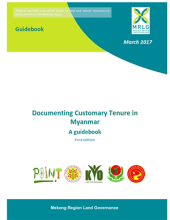Land Library Search
Through our robust search engine, you can search for any item of the over 73,000 highly curated resources in the Land Library.
If you would like to find an overview of what is possible, feel free to peruse the Search Guide.
/ library resources
Showing items 1 through 9 of 15.The Mekong Region Land Governance (MRLG) project, MLIKE (Mekong Land Information and Knowledge Exchange), and the Land Portal co-facilitated an online dialogue on “Responsible Large Scale Agricultural Investments in the Mekong Region” on 09-27 October 2017.
This guidebook provides conceptual, legal and practical tools and resources to help civil society organizations guide communities through the process of documenting customary tenure at the local level.
The « Environment and Natural Resources Code of Cambodia » (Sixth Draft – – 20 November 2016) is a very extensive proposed law (535 pages !) which will have, if adopted, major impacts on many aspects of Cambodian development (Mines, Energy, Urban planning, etc..) but is particularly important for
The inspiration for this sourcebook came from a 2014 meeting of researchers, practitioners and policy makers in Addis Ababa under the auspices of an event co-convened by the Global Water Initiative East Africa (GWI EA), the International Water Management Institute (IWMI) and the Water, Land and E
Natural resources such as land, water, timber, minerals, metals and oil are vitally important sources of livelihoods, income and influence for countries and communities around the globe.
This paper, which focuses on the Chinyanja Triangle (CT), an area inside the Zambezi River Basin, characterises three distinct farming subsystems across rainfall gradients, namely maize-beans-fish, sorghum-millet-livestock and the livestock-dominated subsystem.
Many analysts of grassroots conflicts in African emphasized one of the following factors to be the most important: ethnic divisions, competition over resources or competition between pastoralists and agriculturalists. The role of elites has been down played in such conflicts.
This paper summarises the case for greater consideration of the economic dimensions of conflicts in mediation processes – particularly those concerning natural resources.
Using the Khanasser Valley in Syria as an example, this paper looks at Integrated Natural Resource management (INRM) as an approach to tackle land degradation.




